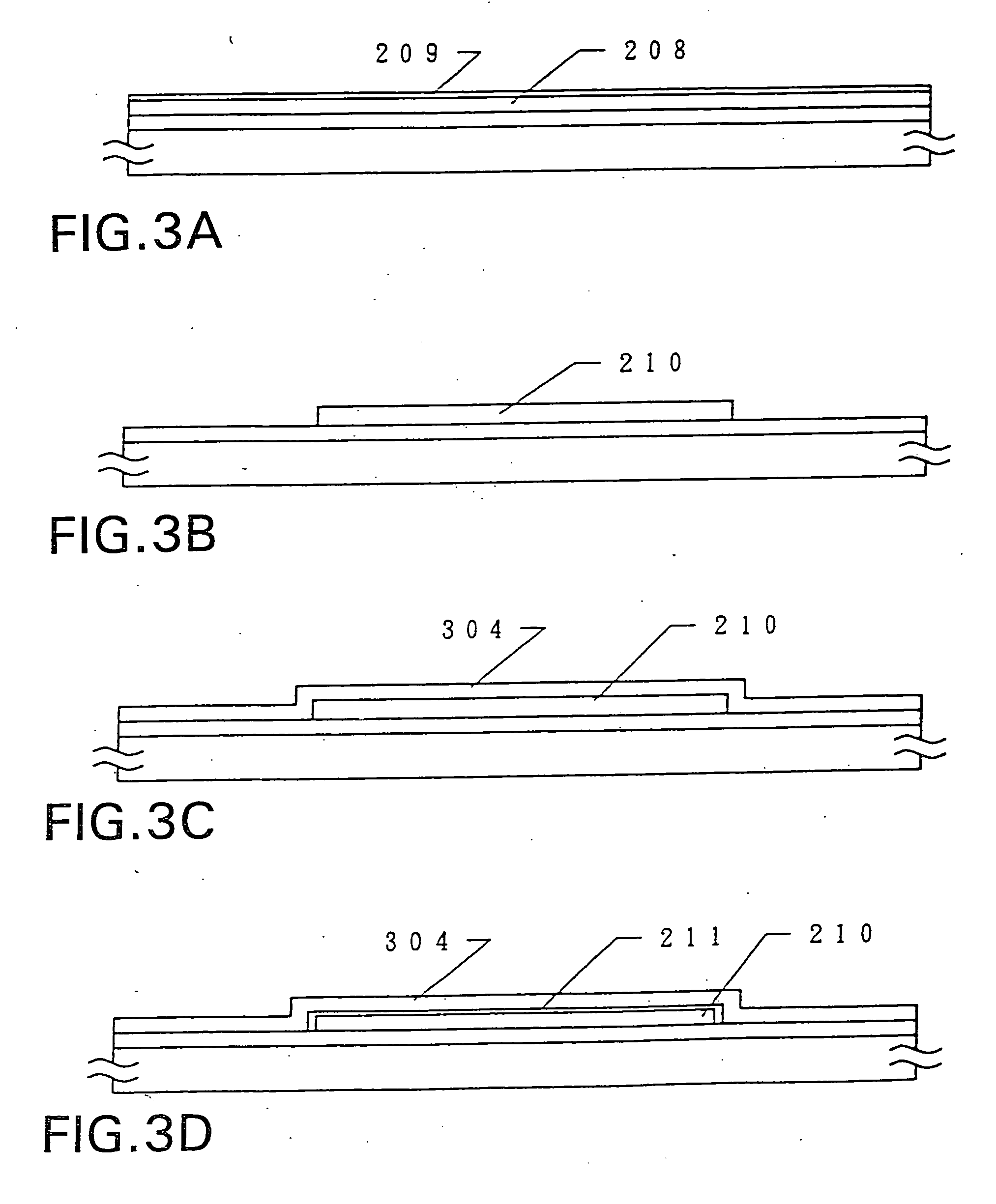Semiconductor device and its manufacturing method
a semiconductor and manufacturing method technology, applied in the direction of semiconductor devices, electrical devices, transistors, etc., can solve the problems of difficult circuit formation, and achieve the effect of superior characteristics
- Summary
- Abstract
- Description
- Claims
- Application Information
AI Technical Summary
Benefits of technology
Problems solved by technology
Method used
Image
Examples
embodiment 1
[0065] This embodiment is directed to a method of effecting crystal growth parallel with a substrate (called “lateral growth”) by selectively introducing into an amorphous silicon film a metal element that accelerates crystallization of silicon.
[0066]FIGS. 1A-1D and FIGS. 2A-2E show a manufacturing process according to this embodiment. First, a 3,000-Å-thick silicon oxide film as an undercoat film 202 is formed on a quartz substrate 201. The undercoat film 202 can be omitted if the quartz substrate 201 is sufficiently smooth and if sufficient cleaning is performed.
[0067] Although the use of a quartz substrate is preferable at present, the invention is not limited to the use of a quartz substrate and other substrates can also be used as long as they withstand a heat treatment temperature.
[0068] Next, a 600-Å-thick amorphous silicon film 203 as a starting film of a crystalline silicon film is formed by low-pressure thermal CVD. It is preferred that the amorphous silicon film 203 be...
embodiment 2
[0114] This embodiment is directed to a case where the gate insulating film forming method is modified in the manufacturing method of the first embodiment.
[0115]FIGS. 3A-3D show a manufacturing method according to this embodiment. A crystalline silicon film 208 having a lateral growth region is formed by the steps of FIGS. 1A and 1B. The thickness of an amorphous silicon film as a starting film is set at 500 Å.
[0116] Once the crystalline silicon film 208 is formed, a 200-Å-thick thermal oxidation film 209 is formed by performing a heat treatment of 950° C. for 30 minutes or more by an electrical furnace in an oxygen atmosphere containing HCl at 3%. (FIG. 3A)
[0117] After the thermal oxidation film 209 is removed, the crystalline silicon film 208 is patterned into a pattern 210 which will become a TFT active layer. (FIG. 3B)
[0118] Next, a 1,000-Å-thick gate insulating film 304 is formed by plasma CVD. (FIG. 3C)
[0119] A 300-Å-thick thermal oxidation film 211 is then formed by a he...
embodiment 3
[0123] This embodiment is directed to a manufacturing method of an active matrix circuit region of an active matrix liquid crystal display device.
[0124]FIGS. 4A-4D show a manufacturing process according to this embodiment. First, the state of FIG. 2D (also shown in FIG. 4A) is obtained by the process of the first embodiment.
[0125] Next, a 2,000-Å-thick silicon nitride film 401 as a first interlayer insulating film is formed by plasma CVD. A polyimide resin film 402 is formed thereon by spin coating, to obtain the state of FIG. 4B. Resin materials other than polyimide, such as polyamide, polyimideamide and acrylic resin, may also be used.
[0126] After contact holes are formed so as to reach the source region 311 and the drain region 315, a source electrode 403 and a drain electrode 403 are formed each of which is a laminate film of a titanium film, an aluminum film, and a titanium film. The source electrode 403 is so formed as to extend from a source line. (FIG. 4C)
[0127] Part of ...
PUM
 Login to View More
Login to View More Abstract
Description
Claims
Application Information
 Login to View More
Login to View More - R&D
- Intellectual Property
- Life Sciences
- Materials
- Tech Scout
- Unparalleled Data Quality
- Higher Quality Content
- 60% Fewer Hallucinations
Browse by: Latest US Patents, China's latest patents, Technical Efficacy Thesaurus, Application Domain, Technology Topic, Popular Technical Reports.
© 2025 PatSnap. All rights reserved.Legal|Privacy policy|Modern Slavery Act Transparency Statement|Sitemap|About US| Contact US: help@patsnap.com



